Logic Pro X User Guide
- Welcome
-
- What is Logic Pro?
- Workflow overview
- Logic Pro project basics
- Advanced tools and additional options
- Undo and redo edits
- Manage Logic Pro content
- How to get help
-
- Projects overview
- Create projects
- Open projects
- Save projects
- Delete projects
-
- Play a project
- Set the playhead position
- Control playback with the transport buttons
- Use transport shortcut menus
- Use transport keyboard shortcuts
- Customize the control bar
- Change the LCD display mode
- Monitor and reset MIDI events
- Use the cycle area
- Use the Chase Events function
- Control Logic Pro using Apple Remote
- Control Logic Pro projects using Logic Remote
- Preview projects in the Finder
- Close projects
- View project information
-
- Overview
-
- Before recording software instruments
- Play software instruments
- Record software instruments
- Record additional software instrument takes
- Overdub software instrument recordings
- Spot erase software instrument recordings
- Use Note Repeat
- Record to multiple software instrument tracks
- Replace software instrument recordings
- Record multiple MIDI devices to multiple tracks
- Record software instruments and audio simultaneously
- Use step input recording techniques
- Use the metronome
-
- Overview
-
- Regions overview
- Select regions
- Select parts of regions
- Cut, copy, and paste regions
- Move regions
- Add or remove gaps
- Delay region playback
- Loop regions
- Repeat regions
- Resize regions
- Mute and solo regions
- Time stretch regions
- Split regions
- Demix MIDI regions
- Join regions
- Create regions in the Tracks area
- Normalize audio regions in the Tracks area
- Create aliases of MIDI regions
- Clone audio regions
- Change the color of regions
- Convert audio regions to Sampler sample zones
- Rename regions
- Delete regions
-
- Overview
-
- Add notes
- Select notes
- Snap items to the grid
- Move notes
- Copy notes
- Change the pitch of notes
- Resize notes
- Edit note velocity
- Quantize the timing of notes
- Quantize the pitch of notes
- Change note articulations
- Lock the position of events
- Mute notes
- Change note color
- View note labels
- Delete notes
- Time stretch notes
- View multiple MIDI regions
- Split chords
- Automation/MIDI area in the Piano Roll Editor
- Open other editors
-
- Flex Time and Pitch overview
-
- Flex Pitch algorithm and parameters
- Edit the pitch of audio in the Audio Track Editor or a zoomed in track
- Edit the pitch of audio in the Tracks area when the track is not zoomed in
- Correct the timing of audio regions with Flex Pitch
- Quantize the pitch of audio regions
- Create MIDI from audio recordings
- Change the gain of audio regions
- Use Varispeed to alter the speed and pitch of audio
-
- Mixing overview
- Set channel strip input formats
- Set channel strip pan or balance positions
- Mute and solo channel strips
-
- Plug-ins overview
- Add, remove, move, and copy plug-ins
- Insert a plug-in on a track using drag and drop
- Activate plug-ins on inactive channels
- Use the Channel EQ
- Work in the plug-in window
- Work with plug-in settings
- Work with plug-in latencies
- Work with Audio Units plug-ins
- Support for ARA 2 compatible plug-ins
- Use the Plug-in Manager
- Work with channel strip settings
- Surround panning
- Use the I/O Labels window
- Undo and redo Mixer and plug-in adjustments
-
- Smart Controls overview
- Show Smart Controls for master effects
- Choose a Smart Control layout
- Automatic MIDI controller assignment
- Map screen controls automatically
- Map screen controls
- Edit mapping parameters
- Use parameter mapping graphs
- Open the plug-in window for a screen control
- Rename a screen control
- Use articulation IDs to change articulations
- Assign hardware controls to screen controls
- Compare Smart Control edits with saved settings in Logic Pro
- Use the Arpeggiator
- Automate screen control movements
-
- Live Loops overview
- Start and stop cells
- Work with Live Loops cells
- Change loop settings for cells
- How the Live Loops grid and Tracks area interact
- Edit cells
- Edit scenes
- Work in the Cell Editor
- Record a Live Loops performance
- Change Live Loops grid settings
- Control Live Loops in Logic Pro with other devices
-
- Overview
- Add notes
-
- Part box overview
- View score symbols
- Select score symbols
- Add notes and rests
- Add notes and symbols to multiple Logic Pro regions
- Add key and time signature changes
- Change the clef sign
- Add dynamic marks, slurs, and crescendi
- Change note heads
- Add symbols to notes
- Add trills, ornaments, and tremolo symbols
- Add sustain pedal markings
- Add chord symbols
- Add chord grids and tablature symbols
- Add bar lines, repeats, and coda signs
- Add page and line break symbols
-
- Select notes
- Move and copy notes
- Change note pitch, duration, and velocity
- Change note articulations
- Quantize the timing of notes
- Restrict note input to the current key
- Control how ties are displayed
- Add and edit tuplets
- Override display quantization using tuplets
- Add grace notes and independent notes
- Delete notes
- Use automation in the Score Editor
-
- Staff styles overview
- Assign staff styles to tracks
- Staff Style window
- Create and duplicate staff styles
- Edit staff styles
- Edit staff, voice, and assign parameters
- Add and delete staffs or voices in the Logic Pro Staff Style window
- Copy staffs or voices in the Logic Pro Staff Style window
- Copy staff styles between projects
- Delete staff styles
- Assign notes to voices and staffs
- Display polyphonic parts on separate staffs
- Change the staff assignment of score symbols
- Beam notes across staffs
- Use mapped staff styles for drum notation
- Predefined staff styles
- Share a score
-
- Environment overview
- Common object parameters
- Customize the Environment
-
-
- Fader objects overview
- Use fader objects
- Play back fader movements
- Work with object groups
- Fader styles
- Fader functions: MIDI events
- Fader functions: range, value as
- Fader functions: filter
- Vector fader
- Special faders overview
- Cable switchers
- Meta event faders
- SysEx faders
- Work with SysEx messages
- Special functions
- Ornament objects
- MMC record buttons
- Keyboard objects
- Monitor objects
- Channel splitter object
- Physical input objects
- Physical input objects
- MIDI click objects
-
-
- Key commands overview
- Browse, import, and save key commands
- Assign key commands
- Copy and print key commands
-
- Global Commands key commands
- Global Control Surfaces Commands
- Various windows
- Windows Showing Audio files
- Main Window Tracks and Various Editors
- Live Loops Grid
- Various Editors
- Views showing Time Ruler
- Main Window Tracks
- Mixer
- MIDI Environment
- Piano Roll
- Score Editor
- Event Editor
- Step Editor
- Step Sequencer
- Project Audio
- Audio File Editor
- Smart Tempo Editor
- Sampler
- Step Input Keyboard
- Tool key commands in Logic Pro
- Touch Bar shortcuts
-
-
- Working with your control surface
- Connect control surfaces
- Add a control surface to Logic Pro
- Automatic assignment for USB MIDI controllers
- Grouping control surfaces
- Control Surfaces preferences overview
- Modal dialog display
- Tips for using your control surface
- Control surfaces supported by Logic Pro
- Software and firmware
-
-
- Learn about Effects
-
- Learn about Amps and Pedals
-
- Bass Amp Designer overview
- Bass amplifier models
- Bass cabinet models
- Build a custom combo
- Amplifier signal flow
- Pre-amp signal flow
- Use the D.I. box
- Amplifier controls
- Bass Amp Designer effects overview
- Bass Amp Designer EQ
- Bass Amp Designer compressor
- Bass Amp Designer Graphic EQ
- Bass Amp Designer Parametric EQ
- Bass Amp Designer microphone controls
-
- Use MIDI plug-ins
-
- Arpeggiator overview
- Arpeggiator control parameters
- Note order parameters overview
- Note order variations
- Note order inversions
- Arpeggiator pattern parameters overview
- Use Live mode
- Use Grid mode
- Arpeggiator options parameters
- Arpeggiator keyboard parameters
- Use keyboard parameters
- Assign controller parameters
- Modifier MIDI plug-in controls
- Note Repeater MIDI plug-in controls
- Randomizer MIDI plug-in controls
-
- Use the Scripter MIDI plug-in
- Use the Script Editor
- Scripter API overview
- MIDI processing functions overview
- HandleMIDI function
- ProcessMIDI function
- GetParameter function
- SetParameter function
- ParameterChanged function
- Reset function
- JavaScript objects overview
- Use the JavaScript Event object
- Use the JavaScript TimingInfo object
- Use the Trace object
- Use the MIDI event beatPos property
- Use the JavaScript MIDI object
- Create Scripter controls
- Transposer MIDI plug-in controls
-
- Learn about included Instruments
-
- Alchemy overview
- Name bar
-
- Alchemy source overview
- Source master controls
- Import browser
- Source subpage controls
- Source filter controls
- Source filter use tips
- Source elements overview
- Additive element controls
- Additive element effects
- Spectral element controls
- Spectral element effects
- Pitch correction controls
- Formant filter controls
- Granular element controls
- Sampler element controls
- VA element controls
- Source modulations
- Morph controls
- Master voice section
- Alchemy extended parameters
-
- Logic Pro Quick Sampler overview
- Add content to Logic Pro Quick Sampler
- Logic Pro Quick Sampler waveform display
- Use Flex in Logic Pro Quick Sampler
- Logic Pro Quick Sampler Pitch controls
- Logic Pro Quick Sampler Filter controls
- Quick Sampler filter types
- Logic Pro Quick Sampler Amp controls
- Logic Pro Quick Sampler extended parameters
-
- Sculpture overview
- Sculpture interface
- Global parameters
- Amplitude envelope parameters
- Use the Waveshaper
- Filter parameters
- Output parameters
- Use surround range and diversity
- Assign MIDI controllers
- Extended parameters
-
-
- Ultrabeat overview
- Ultrabeat interface
- Synthesizer section overview
- Filter section controls
- Distortion circuit controls
- Glossary

Create zones in Logic Pro Sampler
A zone is a location into which a single audio file—or sample, if you prefer this term—can be loaded. The sample loaded into the zone is memory resident—it uses the RAM of your computer. You can define as many zones as needed.
A zone offers parameters that control sample playback. You can set the key range—the range of notes that the sample spans—and the root key—the note at which the sample sounds at its original pitch for each zone. In addition, you can adjust sample start, end, and loop points, volume, and several other parameters for the zone.
Sampler provides several methods you can use to create and add zones. You can quickly add a single zone to Sampler by dragging an audio file, audio or software instrument region, or Apple Loop to the Mapping or Zone panes or the instrument track header. You can create multiple zones by dragging multiple audio files, regions, or loops into the Sampler Mapping pane. You can also manually create a zone and can add an audio file by using menu options. You can also choose whether the new zone maps samples chromatically or based on analysis of the material.
Create groups and zones by dragging audio files onto the Navigation bar
In Logic Pro Sampler, you can drag audio files to the Navigation bar. The Navigation bar provides Chromatic and Optimized import options. Each of these divides into two dropzones when you drag audio onto it.

Chromatic: Audio files are mapped, as zones, chromatically across the keyboard range, starting from C2. Each zone is mapped to a single key on the keyboard. The original file length, tuning, and volume are used. Looping data is read from the file header, if present.
Zone per File: Creates a group containing one zone for each file dropped on the dropzone.
Split at Silence: Creates a new group for each file dropped on the dropzone. Each file is split at extended periods of silence, with a zone created in the associated group for each of these segments.
Depending on the audio material and existing zones, the zone per file import of several audio files may result in the following:
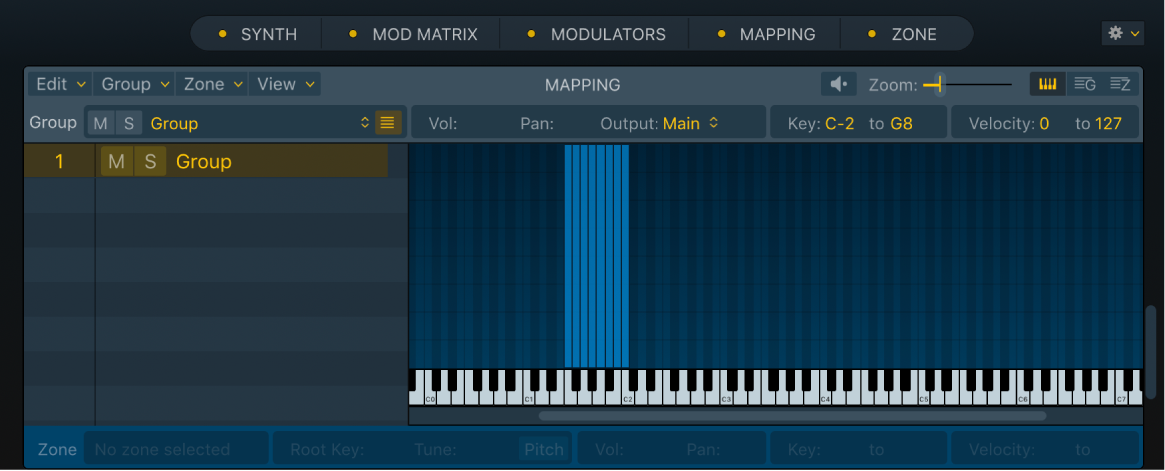
Optimized: Automatically determines the root note of the zones and maps them across the keyboard. If multiple zones have the same root note, velocity layers based on the perceived loudness of the samples are created. Loop point data in the file header is used, if present. If the file header does not contain looping data a search is performed to find the best loop points, and the crossfade length and type are automatically set. The file is also analyzed to find the perceived loudness, and the volume is raised or lowered to achieve a perceived loudness of -12 LUFs. Start and end markers are also automatically set to crop silence that precedes or follows the analyzed audio.
Zone per File: Creates a group containing one zone for each file dropped on the dropzone.
Zone per Note: Creates a new group for each file dropped on the dropzone. A new zone is created for each pitched note that is of sufficient duration and harmonicity to be detected in the audio file.
Depending on the audio material and existing zones, analysis of a single file by note may result in the following:

Depending on the audio material and existing zones, analysis of multiple files by note may result in the following:

Create an empty zone with a menu command, and assign a sample to it
In the Logic Pro Sampler Mapping pane, choose Zone > New Zone (or use the New Zone key command).
A new group is shown in the Mapping pane and a zone is automatically added to the group.

Do one of the following:
In the Zone pane, drag an audio file into the waveform display area.
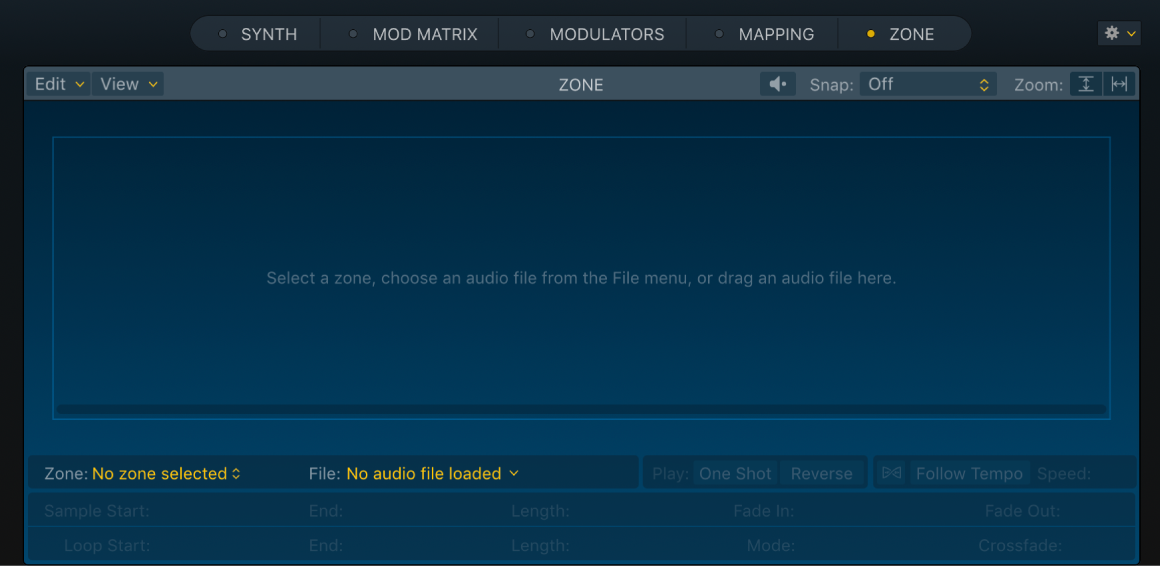
In the Mapping pane zone view, click the empty Name field for the zone in the Audio File column, then choose Load Audio File from the pop-up menu.
In the Mapping pane zone view, drag an audio file from the Finder, Loop Browser, or File Browser into the empty Name field of the zone in the Audio File column.
In the Mapping pane keyboard view, hold Command-Shift, then drag to create a new, empty zone. You can add a sample to the zone using any of the methods discussed.
In the Mapping pane keyboard view, drag an audio file from the Finder, Loop Browser, or File Browser directly onto the zone.

If you chose the Load Audio File option in step 2, locate the audio file you want and select it in the File Selector window.

If you select the “Hide used audio files” checkbox, files used in the currently loaded sampler instrument are dimmed.
If you select the “Preview audio file in Sampler Instrument” checkbox, the sample files in the currently selected zone are temporarily replaced. The zone is not directly triggered by selecting this option, but it can be triggered by playing MIDI notes while the File Selector window is open—and different files are chosen. The selected sample can be heard as part of the zone, inclusive of all synthesizer processing (filters, modulation, and so on).
Click the Options button at the lower left of the File Selector window to view or hide the checkboxes and Play button.
To preview looped playback of the currently selected audio file, click the Play button at the lower right of the File Selector window.
You can step through files by using the Down Arrow key, or by clicking them, to audition each file in turn.
Click the Stop button to stop playback.
The Play button label changes to Stop during playback.
When you find an audio file you want to use, click the Open button to add it to the zone.
When the audio file is loaded, the sample name is displayed in the Name field for the zone in the Audio File column.
Create a zone by dragging an audio file into the zone pane
In Logic Pro Sampler, click the Zone button in the Navigation bar to view an empty Zone pane that is ready for you to add audio material.
From the Finder, Loop Browser, or File Browser, drag an audio file into the Zone pane.
The root key for the zone is the key at which the sample is played at its recorded pitch.

Create a zone by dragging an audio file to a key in the Mapping pane keyboard view
In Logic Pro Sampler, click the Mapping button in the Navigation bar to view an empty Mapping pane that is ready for you to add audio material. Click the keyboard view button if keyboard view is not already shown.
From the Finder, Loop Browser, or File Browser, drag an audio file directly onto a key on the keyboard in the Mapping pane.
The root key is shown in gold on the keyboard. The start key, end key, and root key are all set to the note that the file is dragged to.
Note: You can drag multiple audio files to a key in the Mapping pane keyboard view. This automatically creates a stack of layered zones, split by velocities.
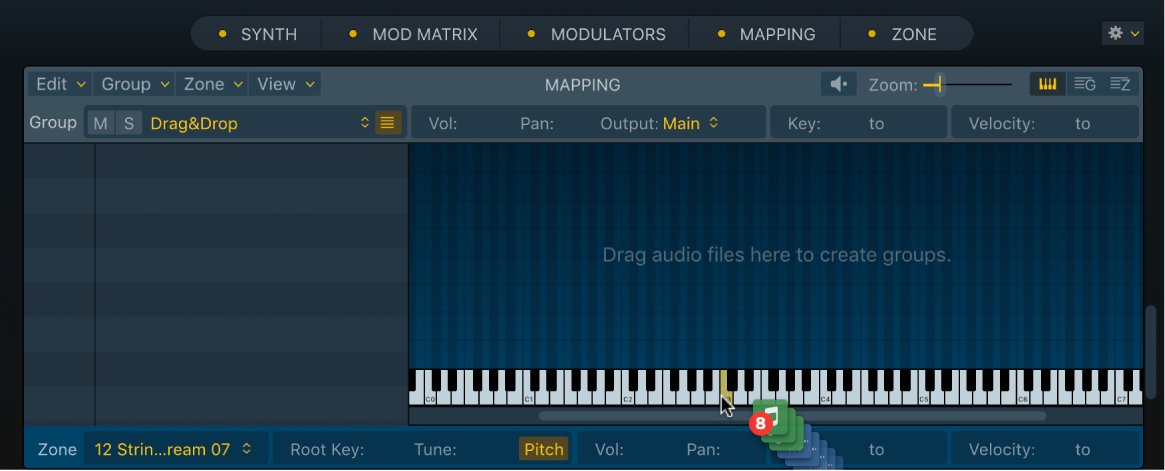
Create a zone by dragging an audio file to a range of keys in the Mapping pane keyboard view
In Logic Pro Sampler, click the Mapping button in the Navigation bar to view an empty Mapping pane that is ready for you to add audio material. Click the keyboard view button if keyboard view is not already shown.
From the Finder, Loop Browser, or File Browser, drag an audio file into the Key Mapping Editor above the keyboard in the Mapping pane.

The drop location changes the import behavior:
When you drop an audio file on the keyboard, it is mapped to that key.
When you drop an audio file onto the Key Mapping Editor above the keyboard, it is mapped to a range of keys. As you drag toward the top of the Key Mapping Editor, the key range expands.
The root key is shown in gold, and the key range (containing the start key and end key) is shown across the keyboard.
Add multiple audio files to the Mapping pane keyboard view
In Logic Pro Sampler, you can add audio files to the Mapping pane in several ways and in different views.
Click the Mapping button in the Navigation bar to view an empty Mapping pane that is ready for you to add audio material. Click the keyboard view button if keyboard view is not already shown.
From the Finder, Loop Browser, or File Browser, drag one or more audio files into the Mapping pane, either directly on the keyboard or the Key Mapping Editor above the keyboard. Shift-click or Command-click to select multiple files.
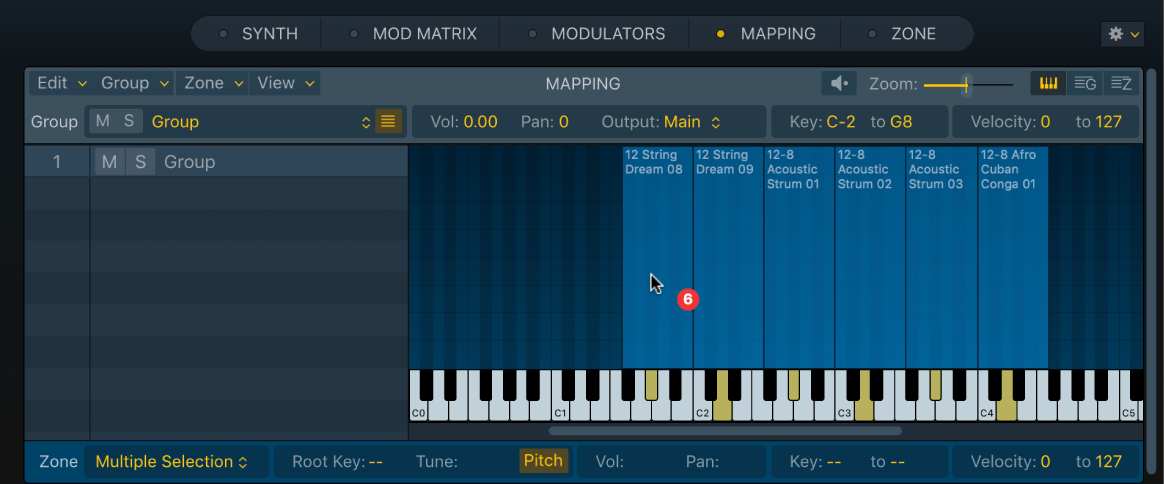
The drop location changes the import behavior:
When you drop an audio file on the keyboard, it is mapped to that key. When you drop multiple audio files on the keyboard, each is mapped to its own key.
The root key is shown in gold on the keyboard. Multiple gold keys are shown when you drag more than one audio file.
When you drop an audio file into the Key Mapping Editor above the keyboard, it is mapped to a range of keys. As you drag toward the top of the Key Mapping Editor, the key range expands.
The root key is shown in gold, and the key range is shown across the keyboard. Multiple gold keys and key ranges are shown when you drag more than one audio file.
Add multiple audio files to the Mapping pane zone view and create a new group
In Logic Pro Sampler, you can add audio files to the Mapping pane in several ways and in different views.
Click the Mapping button in the Navigation bar to view an empty Mapping pane that is ready for you to add audio material. Click the zone view button if zone view is not already shown.
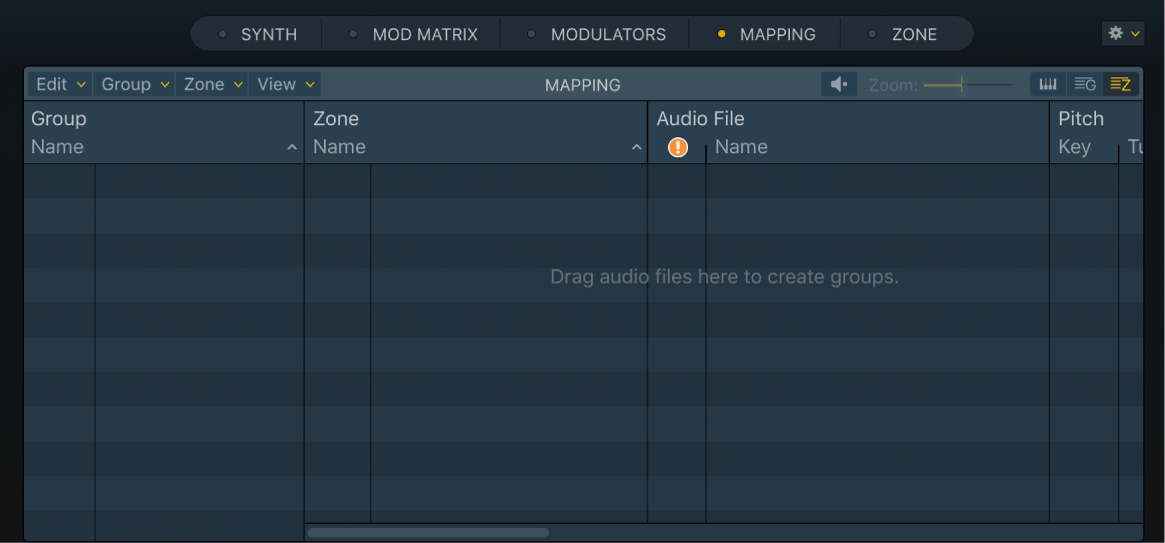
From the Finder, Loop Browser, or File Browser, drag one or more audio files into the Mapping pane zone view. Shift-click or Command-click to select multiple files.
A group is automatically created and the audio file is added to the group. When you drop multiple audio files, all are added to the group.

Add a zone by dragging an audio file, region, or loop to a software instrument track
In Logic Pro, drag a single audio file, region, or Apple Loop to a software instrument track header with a Sampler instrument plug-in inserted.
When the Add new zone dialog appears, drag the item to one of the following:
Sampler (Chromatic Map) maps samples to successive chromatic notes.
Sampler (Optimized Map) maps samples according to analysis of the material.
Add multiple zones by dragging multiple files, regions, or loops to a software instrument track
In Logic Pro, drag multiple audio files, regions, or Apple Loops to a software instrument track header with a Sampler instrument plug-in inserted. Shift-click or Command-click to select multiple files.
When the Add new zones dialog appears, drag the items to one of the following:
Sampler (Chromatic Map) maps samples to successive chromatic notes.
Sampler (Optimized Map) maps samples according to analysis of the material.
Convert audio regions to sampler instruments and tracks
In Logic Pro, you can convert audio regions to sampler instruments with the Convert Regions to New Sampler Track function (default key command: Control-E). All selected regions are sequentially mapped—in accordance with their timeline positions—to the specified key range, starting with the lowest note.
A new track is also created, with automatically created trigger notes for the converted audio regions. These trigger notes match the time positions of the source audio regions. You can reposition or edit the trigger notes in the Piano Roll Editor. You can also change zone parameters in the Sampler Instrument Editor. See Logic Pro Sampler Mapping and Zone pane overview.
In the Main window, select the audio regions you want to convert.
Control-click any selected region, then choose Convert > Convert Regions to New Sampler Track (or use the default key command: Control-E).
In the dialog, choose to Create Zones From either Regions or Transient Markers.
Enter the Instrument Name in the field.
Set the Trigger Note Range in one of the following ways:
Play a low key on your MIDI keyboard to set the low note of the trigger range. Play a second key to set the top note of the trigger range.
Choose a low and high note from the Trigger Note Range pop-up menus.
Click OK to create a new sampler instrument and track, or click Cancel if you change your mind.